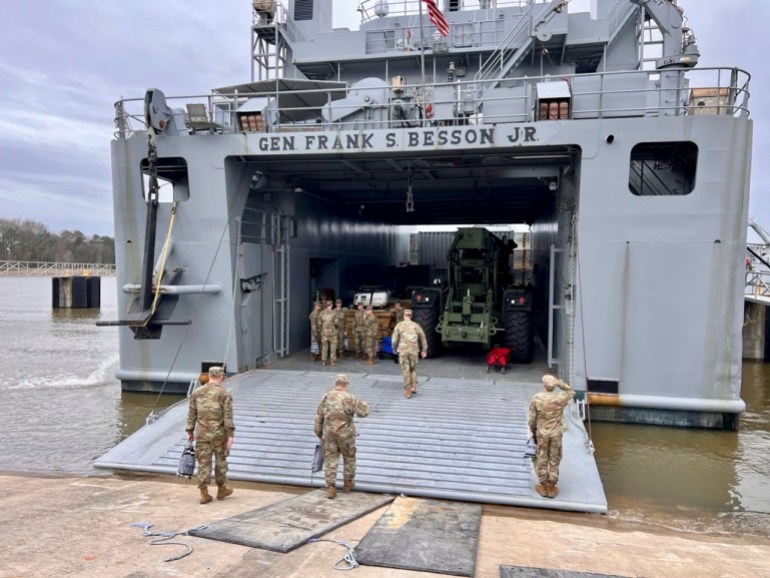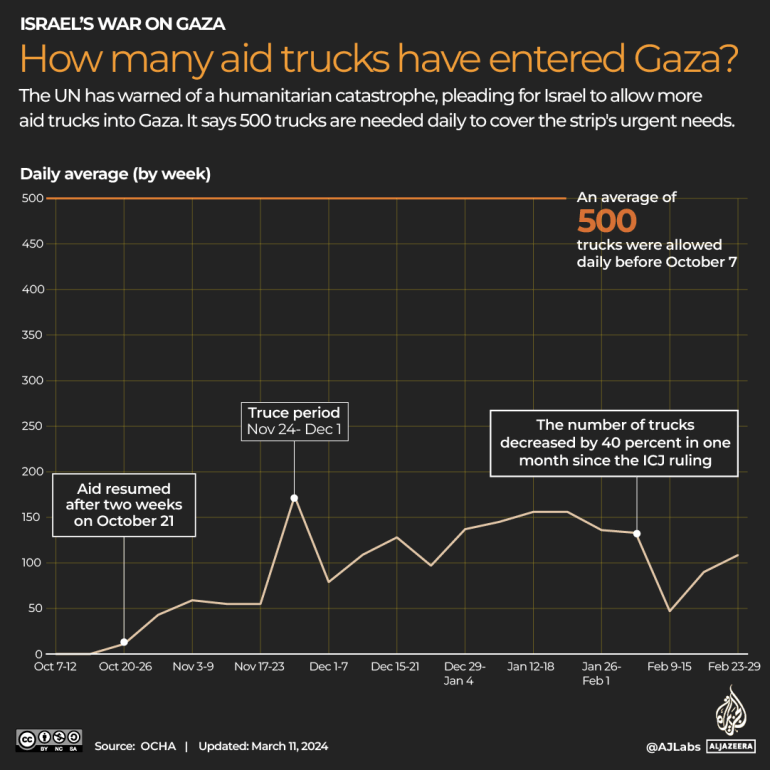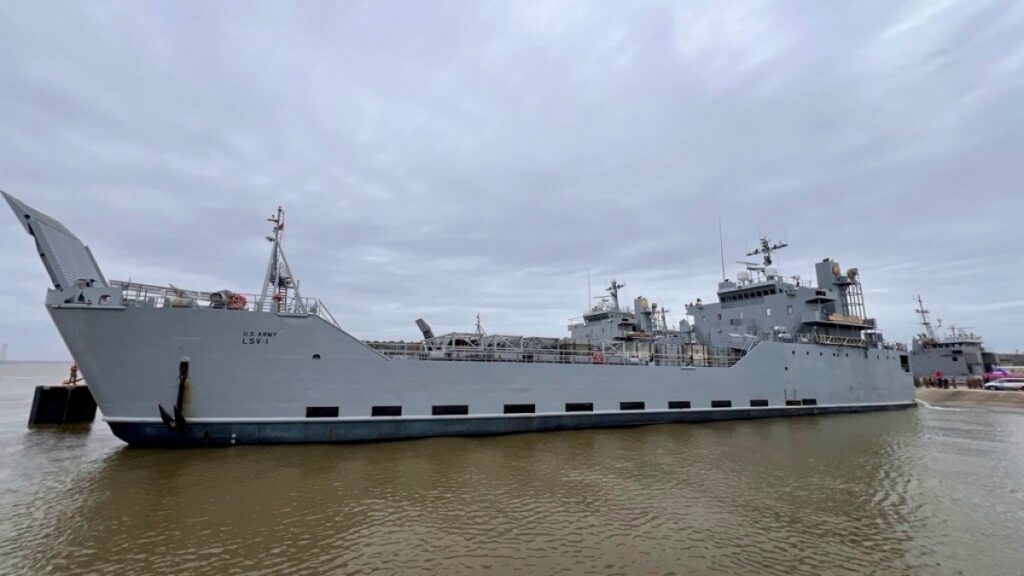President Joe Biden said the United States would set up a temporary pier off the coast of Gaza to deliver humanitarian supplies to the besieged enclave as Palestinians begin to starve under Israel's blockade of the area.
A U.S. military ship loaded with equipment needed for initial construction work on the structure departed for Gaza on Sunday, according to U.S. Central Command.
The move comes as the United States airlifts aid amid looming famine in the Gaza Strip, which has been devastated by more than five months of Israeli shelling, ground operations and siege. Aid agencies say airdrops are not enough given the scale of the crisis. More than 31,000 people have been killed in Gaza, and up to 70 percent of homes have been destroyed or damaged.
Here's what we know so far about the Gaza Pier and how effective it is.
Why is the US building a pier in Gaza?
Biden said in Thursday's State of the Union address that the pier would be able to “accept large volumes of cargo with food, water, medical supplies and temporary shelter.” The reason for the construction, Biden said, is to “significantly increase the amount of humanitarian aid flowing into Gaza every day.”
Israel has blocked the delivery of food, medicine, and other aid through two land border crossings: Rafah with Egypt and Karem Abu Salem (Hebrew: Kerem Shalom) with Israel, leading to starvation and At least 25 people died from dehydration.
From these crossings on the southern edge of the Gaza Strip, trucks carrying humanitarian aid must pass through conflict zones to deliver additional supplies, including to largely cut-off areas in the north.
Biden is running for re-election on November's presidential ballot, but his move is a sign of his unrelenting support for Israel, which is accused of indiscriminately killing civilians and destroying hospitals and homes. This is seen as an attempt to deal with anger within the Democratic Party's support base. and civilian buildings. The International Court of Justice hears genocide cases brought against Israel.
Since October 7, the United States has provided billions of dollars in aid as well as weapons used by Israel in Gaza. In addition to the $3.8 billion in annual military aid, an additional $14 billion in aid to Israel is currently before the U.S. Congress. It passed the Senate last month, but its fate in the House is unclear.
Voting is currently underway in the presidential primaries and caucuses, but some Democrats are refusing to vote for Biden, leaving former President Donald Trump with a narrow lead over the Democratic incumbent. There are concerns about Biden's ability to attract voters in the November election. poll.
How will Gaza's floating pier work?
British Foreign Secretary David Cameron said Britain would take part in the pier project, but added: “It will take time to build.”
The Pentagon provided a timeline Friday, saying the dock construction project could take up to 60 days and involve more than 1,000 U.S. troops.
[BELOW: We need a caption for this photo. What is it and what does it say in relation to this story?]

U.S. defense officials said the 7th Transportation Brigade, based at Joint Base Langley-Eustis in Virginia, is beginning to maintain so-called “coastal joint logistics” equipment and watercraft. This is compared to a large Lego system in which 12-meter (40-foot) long pieces of steel are fastened together to form piers and causeways.
The Pentagon said it has not yet determined how the floating port system's landing site will be secured from any threats and is in discussions with partners, including Israel.
Pentagon spokesman Patrick Ryder said there was a risk that Hamas could attack the port system. He added that US forces would not enter Gaza, even temporarily, to complete port construction.
Instead, there are likely to be allies, contractors, and aid agencies on the ground in Gaza.
There are two elements to the pier plan. The first is a floating barge at sea that can accept shipments of relief supplies. From there, the U.S. military would move supplies to a 550-meter (1,800-foot-long) floating causeway anchored on the shore.
Ryder said once the pier is operational, it will be able to deliver about 2 million meals to Gaza each day.
In total, the United States delivered approximately 124,000 meals in four airdrops over the past week. The latest airlift on Friday delivered about 11,500 meals, according to the U.S. military.
Gaza already has a small port near Gaza City's Lemal district. However, the port has been under Israeli naval blockade since 2007, when Israel closed almost all border crossings in the Gaza Strip. Israel claims full control of the Gaza Strip's coastline and territorial waters and has blocked ships from reaching the Strip since 1967.
Biden said the Israeli government would maintain the safety of the pier. It is unclear who will unload the aid at the pier and move it to shore. Experts have questioned why Israel would allow aid to be delivered by sea, since it has made it impossible to deliver aid through land borders.
Will this pier help solve Gaza's aid problem?
The pier appears to be a complicated workaround for a problem that has a simpler solution: Israel opening a land route to Gaza.
Juliet Touma, head of the United Nations Relief and Works Agency for Palestine Refugees (UNRWA), said: “Any effort to bring more humanitarian aid into Gaza to help desperate people is absolutely welcome.” “But there is a more efficient, cheaper and faster way to get aid to Gaza: by land.”
Touma told Al Jazeera that a minimum of 500 aid trucks are needed each day to meet the needs of Palestinian civilians in Gaza. This was the average number of trucks that entered Gaza before the war.
However, the situation changed completely after October 7th. In February, an average of 90 trucks a day entered the enclave, but on some days there were as few as seven or nine trucks.
Thoma also pointed out that no aid trucks entered Gaza for the first two weeks of the war. This leaves a backlog of 5,000 trucks that have yet to be replenished, further exacerbating the aid shortage in the enclave.
Gaza's markets are closed and the enclave's entire population is dependent on aid. “We need far more trucks coming in, not fewer,” she said, adding that Israel needs to take steps to allow more trucks to smoothly enter the enclave. Ta.
He said the best thing the United States could do to most effectively support Gaza's aid crisis is to urge Israeli authorities to increase working hours at the Karem Abu Salem crossing, the only open crossing between Israel and Gaza. He added that it was about adding more pressure. Additionally, he said Israel should be advised to open more intersections and increase the number of trucks allowed.
Due to Israeli restrictions, hundreds of trucks loaded with aid are waiting on the Egyptian side.
Humanitarian organization Refugees International released a report Thursday saying Israel is creating “famine-like conditions” in the Gaza Strip while “obstructing and undermining the humanitarian response.” The report deemed the situation in Gaza “apocalyptic.”
Campaigners said there should be no time wasted in providing aid as Palestinians face starvation-like conditions.
“How long will it take to build a port?” Now people are starving to death. When people reach this level of hunger, there is a time when interventions can help. They don't have weeks,” said Meg Sattler, CEO of the international non-governmental organization Ground Truth Solutions.
Palestinian politician Mustafa Barghouti told Al Jazeera last week: “This is the real problem here: 700,000 people from northern Gaza are starving and Israel is denying them the humanitarian aid they need. It looks like just another attempt to divert attention from the situation,” he told Al Jazeera.
What efforts are other countries making to send aid to Gaza?
On Sunday, the maritime corridor was scheduled to deliver aid from Cyprus to Gaza. This is due to the cooperation of many partners, including European countries, the United States and the United Arab Emirates.
However, the aid did not arrive on time and remained stalled in Cyprus due to technical problems.

